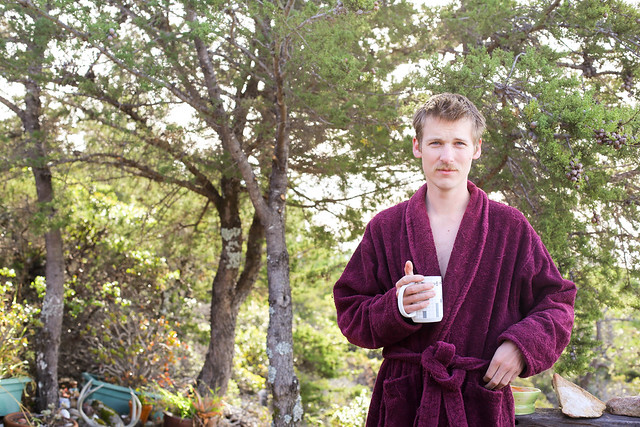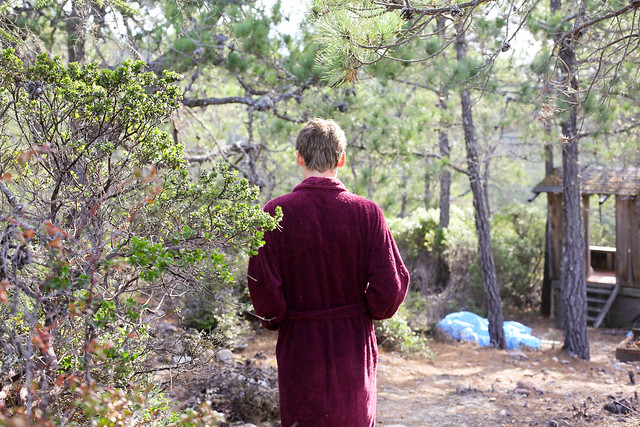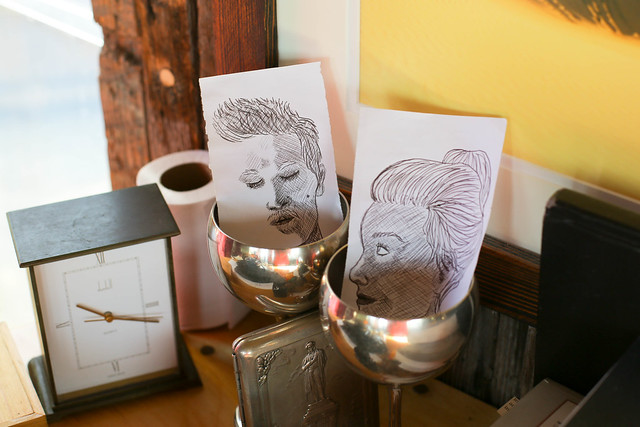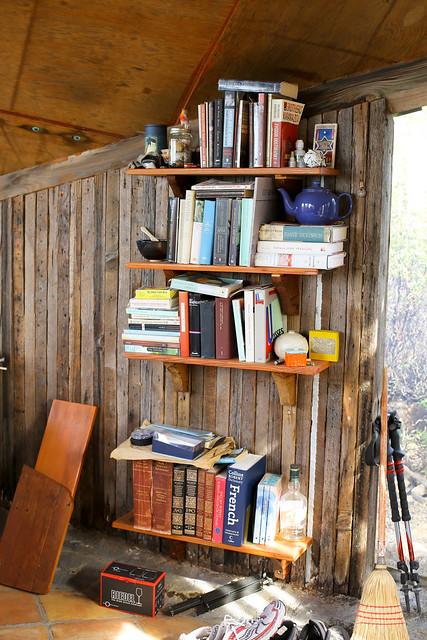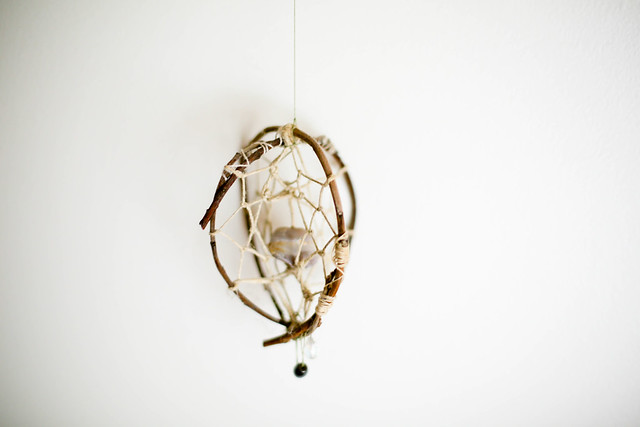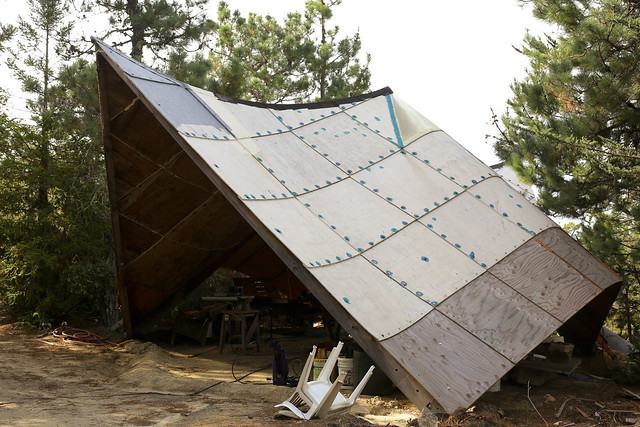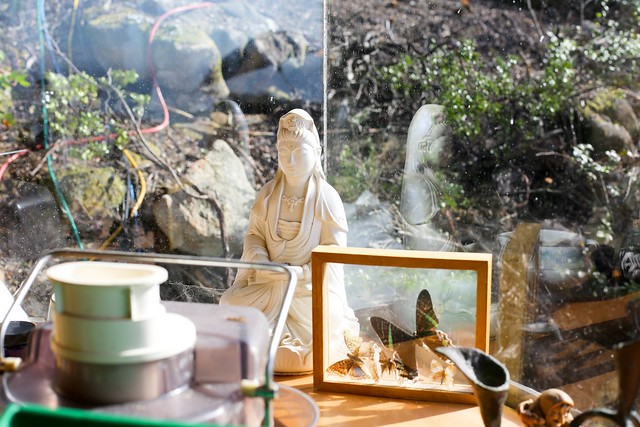*In the morning the light was unbearably bright, more golden and harsh than would be expected on a February day. The first light of day makes everyone look angelic; even the shadows that crease into crevices of skin herald the morning light. By dusk, light is soft and glowy, tired from its daylong shining, but the arc of the sun between dawn and high noon is a blazing trail, a space for strength and glory.

*Jasper knocked on the door to say that coffee was ready and offered to bring it to the room. Coffee sounded tempting, but the first moments upon waking, when waking is of your own accord and not out of obligation, are some of the most precious and calm. So we stayed for awhile, basking in that perfect subtle heat.
*Later we went outside on the deck and had coffee with Jasper. He was wearing a long furry scarlet robe, with a NY Times crossword mug in one hand, a cigarette in another. He sat on the railing overlooking the panorama of trees and ocean and clouds below, his long legs resting in delicate parallel balance on the wooden railing.
*We sat and talked for awhile, and then Jasper and I took a walk through backyard, which is probably the biggest and best backyard I’ve seen. We walked barefoot on a semblance of a trail, which was rocky and covered in brush and pines. We dodged trees and branches, first passing by an outhouse and compost area, and then finally arriving at Jasper’s humble abode, the Hogon.
*The Hogon is a one-room wooden conic shelter built by Jasper and his father. Its roof looks like a hat worn by rice paddy farmers. The base is lined with concrete, and plexiglass windows held together by a wooden skeleton fill in most of the sides, enhanced by bright tie-dye curtains and stained glass, Jasper’s handiwork. A four-minute walk from the main house, the hogon is where Jasper reads and sleeps. The glass door opens to a writing table filled with objects from another time and place–objects that seem anachronistic not because of their existence but because of the effort taken to procure them. Typewriters and oil lamps seem silly and romantic now–a luddite’s proclamation or a self-conscious aesthetic statement. But Jasper pointed out that the lack of electricity in the hogon made these objects practical, and I never doubt his earnestness, which I have known to be true since I first met him, backpacking through the Carter Mountains on the Appalachian Trail.
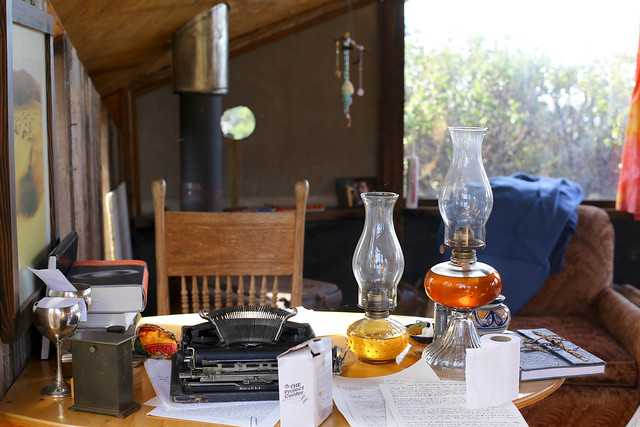
*It’s easy to paint Jasper as a caricature, what with the cigarettes and the robe and the ornate details of his hermit existence, all of which could easily be perceived as the overwrought arrangements of a crafted, romantic life. But after knowing Jasper*** for more than four years, even the most absurd affectations that seem to play into a particular trope, are natural for him.
*Nevertheless, I’m still puzzled and intrigued by Jasper’s effort to simplify his life so selectively. Despite the missing electricity, the limited space, and the communion with nature, the stacks of books (John Updike, poems by Louise Gluck and Emily Dickinson, The Brothers Karamazov, foreign language dictionaries, Beautiful Losers by Leonard Cohen), the silver goblets, and the piles of clothes on the bed betray the minimalism that this kind of lifestyle could initially suggest. In an age where we’re tethered to technology and the absence of electricity is unfathomable, the act of simplification can sometimes stem from an elaborate, self-decorative impulse. Ridding oneself of modern accoutrements often seems more difficult than just living within it all, strangely enough. Do we seek out vintage objects because of aesthetic fondness for a misplaced nostalgia? Do we abscond into the woods because it’s a romantic distraction? Are we obsessed with living out ideal lifestyles instead of figuring how to live? The former is easy and trivial, and I am certainly guilty of doing so. It’s easy to confuse minimalism with luddite living, and simplicity with certain aesthetic choices. Clearing out the noise has never felt so effortful or complicated.
***Jasper was also the subject one of my very first photo assignments in college, back in 2008. During the shoot, he smoked an entire cigar until his face turned blue.
More pictures after the jump...

